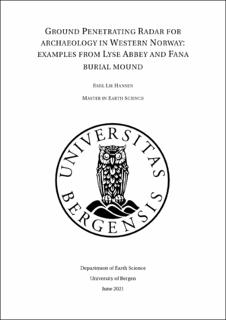Ground penetrating radar for archaeology in Western Norway: Examples from Lyse Abbey and Fana burial mound
Master thesis
Permanent lenke
https://hdl.handle.net/11250/2759630Utgivelsesdato
2021-06-01Metadata
Vis full innførselSamlinger
- Master theses [106]
Sammendrag
In recent years, ground penetrating radar (GPR) has been an important geophysical tool in archaeological prospecting in Norway with discoveries of high interest such as viking ships and iron age settlements. Western Norway has seen less use use of GPR, not lacking archaeological sites, and this thesis investigates an medieval ruin and an iron age burial mound. By performing a three dimensional survey in a 12th century Cistercian abbey, Lyse Kloster, with a single channel GPR, high resolution time slices of the subsurface revealed many archaeological features. Data has been collected through fieldwork, processed accordingly, and visualized through images, plots and animations. A GPR records amplitudes with time, therefore calculating depth requires knowledge of the material velocity, and a ground water monitoring station yielded valuable information the effect water saturation has on material velocity. The results were time lapses of ground water level change, and calculations of change in material velocity. The effect of water saturation on average material velocity to a deep reflector with assumed constant depth could be quantified, and the response time of ground water level to precipitation helped the understanding of the depositional environment.
